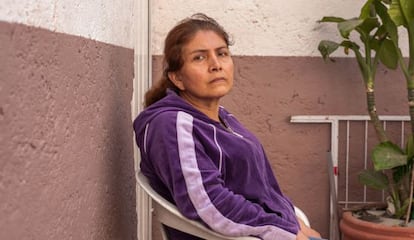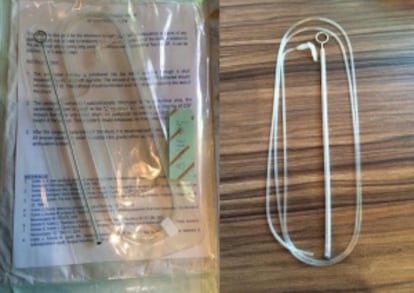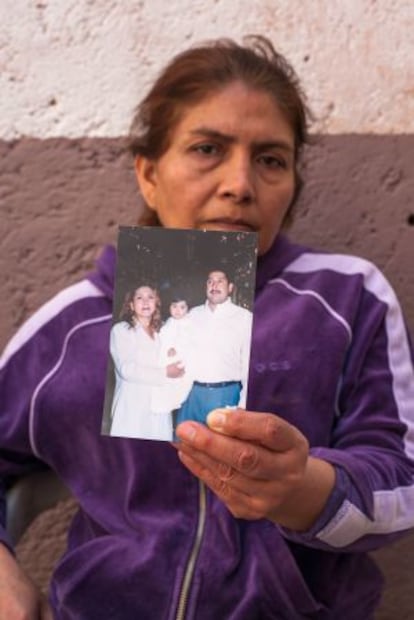The 194 Mexicans who were victims of experimental brain surgery
Catheter developed to treat hydrocephalus was used on patients without their consent


A medical device designed to treat hydrocephalus – the accumulation of fluid on the brain – was implanted in at least 194 Mexicans despite lacking proper authorization for use on humans. That’s according to a report by Mexico’s National Commission for Medical Arbitration, which has found that the device was still in the experimental stage when used, and was implanted without the signed consent needed for such operations. What’s more, the procedures were carried out by unsupervised residents and the damage that was suffered by the victims is irreversible. After 10 years of legal battles, those affected are demanding compensation.
“That’s the way it happened. We were used as part of an experiment,” says María de Lourdes Walkup, 54, an attorney who underwent surgery to remove a brain tumor at the National Institute of Neurology and Neurosurgery (INNN).
Since their procedures, the patients have complained of severe headaches, vomiting and other reactions
Following her operation, she began expelling fluid from her nose. On April 18, 2006, surgeons used the device to drain the excess water on the brain caused by meningitis she had developed. Walkup says doctors told her to sleep upright to alleviate the symptoms.
The problem with the procedure, according to patients who have filed complaints, is that the device lacked a valve to control pressure. In other words, it was just a simple tube that penetrated the brain’s peritoneal area. It only appeared to work if the patient was standing up and not lying down.
Julio Sotelo Morales, inventor of the device and head of the INNN at the time of the procedures, declined EL PAÍS’s request for an interview.

The arbitration commission was severely critical of his actions.
“He should have told patients that this was an experimental procedure,” it wrote in its ruling in the Walkup case. “There is no evidence that he provided patients with this information.”
The Inter-American Court of Human Rights has taken up the complaints by patients, and has assigned each plaintiff with a separate case number.
The material that the tube is made from is commonly used for conventional catheters, but according to a number of neurosurgeons, “it isn’t designed for use within the body.” “And certainly not permanently,” adds former regional deputy and INNN neurosurgeon Rodolfo Ondarza.
“The operations performed at the institute were practically free – the device, which was put together by an orderly, couldn’t have cost more than 40 pesos, and there wasn’t any need to pay doctors’ salaries because they were all interns,” says a nurse who has been working at the INNN for more than 20 years.
They never told us that they were going to use an experimental device” Silvia Walkup, patient’s sister
The INNN’s current director, Teresa Corona, who was chief of interns under Sotelo, also declined a request to be interviewed by EL PAÍS.
But the patients claim that they were given no special discounts for their operations.
“The operation cost us more than 300,000 pesos [about $17,750],” says Walkup’s sister, Silvia. The family has been caring for María de Lourdes ever since the ordeal.
“They never told us that they were going to use an experimental device. All we did was sign some papers for the emergency operation. And we gave our consent, believing they were the best specialists in the country,” Silvia Walkup says.
In Mexico City, Juan Manuel Armenta has become a medical and pharmaceutical expert of sorts. This 50-year-old, who lives in a humble house in the middle of the capital, carries a briefcase filled with 10 years of receipts, including those for medicines and hospital beds.

He also carries his last electricity bill, which is for 23,000 pesos ($1,300). Instead of settling what he owes, that money had to go on the care of his wife, Yolanda Guerrero, who is also 50.
Since they used the device on his wife in 2004, Armenta has been on a constant quest for compensation.
“All we are asking for is that they cover the medical expenses we have had to pay,” he says. Armenta has filed various legal complaints but they were dismissed by the Mexico City Attorney General’s Office.
Yolanda Guerrero is one of the few patients who still has the tube lodged in her brain, because doctors cannot remove it. A valve now regulates the flow of liquid from the other side of her head.
“I carry Sotelo inside of me,” she says in slow speech. “This tube I still have causes massive headaches.”
The ruling made by the National Commission for Medical Arbitration, which was issued specifically for the Walkup case in 2010, established that there was “malpractice by the INNN administrative personnel by allowing the use of a device that was in the research phase as a resource for ordinary medical attention.” In Guerrero’s case, a lawsuit was filed with the health secretary. But for now, the Mexican attorney general has shelved the case. The patients and their families, meanwhile, continue to suffer the consequences of the creation of the center’s former director.
English version by Martin Delfín.
Tu suscripción se está usando en otro dispositivo
¿Quieres añadir otro usuario a tu suscripción?
Si continúas leyendo en este dispositivo, no se podrá leer en el otro.
FlechaTu suscripción se está usando en otro dispositivo y solo puedes acceder a EL PAÍS desde un dispositivo a la vez.
Si quieres compartir tu cuenta, cambia tu suscripción a la modalidad Premium, así podrás añadir otro usuario. Cada uno accederá con su propia cuenta de email, lo que os permitirá personalizar vuestra experiencia en EL PAÍS.
¿Tienes una suscripción de empresa? Accede aquí para contratar más cuentas.
En el caso de no saber quién está usando tu cuenta, te recomendamos cambiar tu contraseña aquí.
Si decides continuar compartiendo tu cuenta, este mensaje se mostrará en tu dispositivo y en el de la otra persona que está usando tu cuenta de forma indefinida, afectando a tu experiencia de lectura. Puedes consultar aquí los términos y condiciones de la suscripción digital.
Últimas noticias
Maduro pleads not guilty before the federal court in New York: ‘I am still the president of Venezuela’
A new test can detect Alzheimer’s from a finger prick
UN team enters Sudanese city of El Fasher after paramilitary massacre: ‘It’s like a ghost town’
A recipe for resistance: Indigenous peoples politicize their struggles from the kitchen
Most viewed
- Gilles Lipovetsky: ‘If you want to live better and fall in love, take Prozac, don’t look to philosophy’
- Alain Aspect, Nobel laureate in physics: ‘Einstein was so smart that he would have had to recognize quantum entanglement’
- Alvin Hellerstein, a 92-year-old judge appointed by Bill Clinton, to preside over Maduro’s trial in New York
- Maduro’s downfall puts China’s relationship with Venezuela to the test
- Why oil has been at the center of Venezuela-US conflicts for decades








































